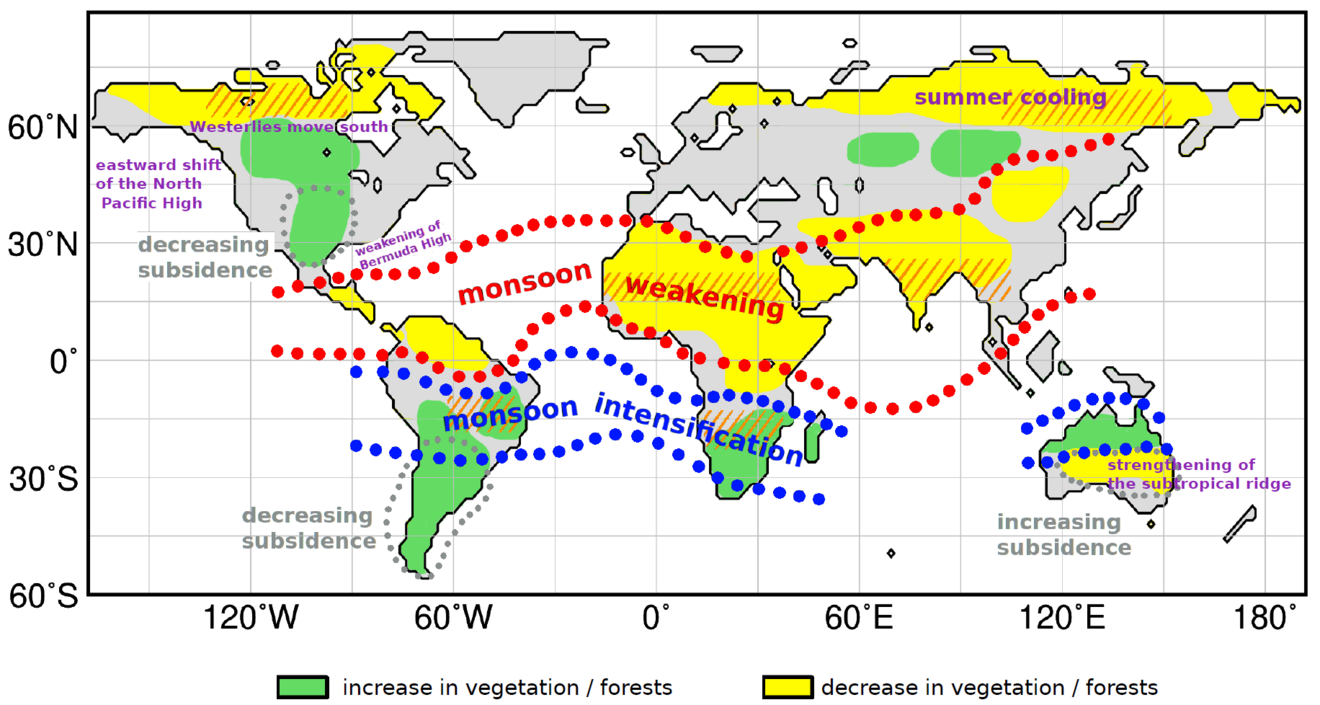Dallmeyer and coauthors have shown that the model captures the main trend seen in the paleo reconstructions well. Most prominent are the southward retreat of the northern tree line that is combined with the strong decrease of forest at high northern latitudes, and the vast increase of the Saharan desert, embedded in a general decrease in precipitation and vegetation in the Northern Hemispheric monsoon margin regions. The Southern Hemisphere experiences weaker changes in total vegetation cover during the last 8000 years (Fig. 1).
What do these changes cause? In a redundancy analysis, the model results confirm the importance of the summer temperature on the taiga-tundra dynamics seen in previous studies. Outside the high northern latitudes, however, precipitation is figured out as the main climatic driver of the Holocene vegetation change. In the monsoon regions, the precipitation changes follow directly the monsoon dynamics that are driven by the Holocene insolation forcing. The Northern Hemisphere summer monsoon systems weaken during the Holocene, leading to a decrease in precipitation and vegetation. The Southern Hemisphere summer monsoons intensify, enhancing precipitation and vegetation. The model results indicate that the monsoon changes in turn affect the atmospheric circulation in the extra-tropics via teleconnections and may therefore be responsible for the decreasing subsidence and increasing rainfall in the North and South American extra-tropics (Fig. 1), triggering an increase in vegetation and forest cover there.
How fast did the global vegetation pattern change? A cluster analysis reveals that the global large-scale vegetation patterns change rather linearly with time, roughly following the subtle insolation forcing. On regional level, however, the simulations show also non-linear, more rapid changes in vegetation. The most striking one is the southern Sahara margin experiencing a rapid increase in desert somewhere during the Holocene due to rising moisture stress. This was already known. However, not known and not yet found in paleo botanic records are rapid shifts in the simulated tree composition that according to the simulations could also occur in the high northern latitudes, in South Asia and in the Southern Hemisphere monsoon margins. These rapid changes are mainly induced by the winter temperature moving in or out of the bioclimatic tolerance range of the different tree types in the model.

Dallmeyer, A., Claussen, M., Lorenz, S., Sigl, M., Toohey, M. & Herzschuh, U. (2021). Holocene vegetation transitions and their climatic drivers in MPI-ESM1.2. Climate of the Past, 17, 2481-2513. doi:10.5194/cp-17-2481-2021
Dr. Anne Dallmeyer
Max Planck Institute for Meteorology
Email: anne.dallmeyer@mpimet.mpg.de
Prof. Dr. Martin Claussen
Max Planck Institute for Meteorology
Email: martin.claussen@mpimet.mpg.de